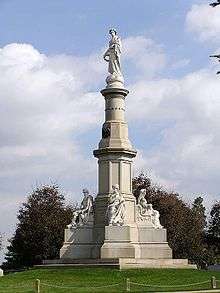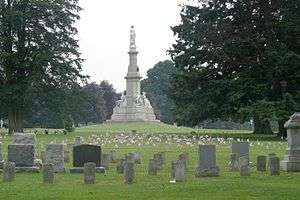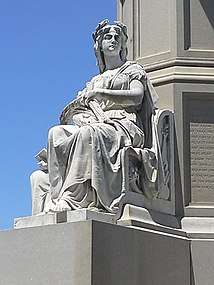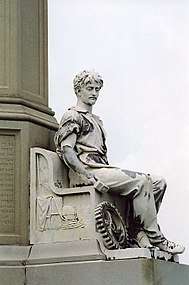Soldiers' National Monument
The Soldiers' National Monument is a Gettysburg Battlefield memorial which is located at the central point of Gettysburg National Cemetery.[4] It honors the battle's soldiers and tells an allegory of "peace and plenty under freedom … following a heroic struggle."[2] In addition to an inscription with the last 4 lines of the Gettysburg Address, the shaft with 4 buttresses has 5 statues:[5]:166
A large statue representing the concept of Liberty surmounts the pedestal. Eighteen large bronze stars circling the pedestal below this statue represent the eighteen Union states with buried dead. Four statues are located at each corner near the base. They represent War, History, Peace, and Plenty. War is represented by a statue of an American soldier who recounts the story of the battle to History. In turn, History records, with stylus and tablet, the achievements of the battle and the names of the honored dead. A statue of an American mechanic and his tools illustrates Peace. Plenty is a female figure with a sheaf of wheat and the fruits of the earth that typify peace and abundance as the soldier's crowning triumph.[2]
 | |
| Coordinates | 39°49.186′N 77°13.873′W[1] |
|---|---|
| Location | Gettysburg National Cemetery |
| Designer | Randolph Rogers George Keller (architect) |
| Beginning date | July 4, 1865[2] |
| Dedicated date | July 1, 1869[3] |

History
Massachusetts approved appropriations to the Gettysburg Soldiers' National Monument Association on March 14, 1865;[6] and in May, David Wills invited veterans organizations for the extensive July 4 cornerstone ceremony[7] (lithographs of the "design proposed by J. G. Batterson"[5]:10 were available by July 19, 1865.)[8] The monument structure was built at Batterson's works at Westerly, Rhode Island,[8] and the Genius of Liberty[3] grasping sword and laurel wreath[9] was sculpted in Rome[3] (arrived October 1868).[10] The monument without the "Plenty" or "Peace" statues[3] was dedicated in 1869 with the prayer by Rev. Henry Ward Beecher, followed by an address by Gen. George G. Meade, oration by Senator Oliver P. Morton, and poem by Bayard Taylor.[11] The monument's "Plenty" statue was placed on August 26, 1869;[12] and a record of the cornerstone and dedication ceremonies was published in 1874.[13] Contrary to popular belief, the monument does not rest on the site of the oration of the Gettysburg Address.[14]
Photo gallery
 History
History Plenty
Plenty Peace
Peace Peace, statue of mechanic holding a mallet in right hand.[15]
Peace, statue of mechanic holding a mallet in right hand.[15]
| Wikimedia Commons has media related to Soldiers National Monument, Gettysburg. |
| Images | |
|---|---|
| Video | |
References
- Swain, Craig (March 8, 2009). "Soldiers' National Monument" (HMdb.org webpage, marker 16864). Retrieved 2013-05-04.
- "Soldiers' National Monument". (MN288). National Park Service. Retrieved 2017-04-07.
- "Gettysburg: Preparations for the Dedication of the Soldiers' Monument" (PDF). New York Times. June 26, 1869. Retrieved 2011-06-25.
Board of Commissioners of the Soldiers' National Cemetery at Gettysburg … most imposing memento of the Civil War anywhere in the country … the marble of both [War & History] statues has been badly disfigured during the passage across the ocean
- Klement, Frank L. (1993). The Gettysburg Soldiers' Cemetery and Lincoln's Address: Aspects and Angles. Shippensburg, PA: White Mane Publishing Co., Inc. p. 15.
- Description of the Gettysburg Monument (Internet Archive--transcription available at Archive.org). Soldiers' National Cemetery, at Gettysburg. Harrisburg, Pennsylvania: Singerly & Myers, State Printers. 1867 [original year tbd]. p. 166. Retrieved 2011-06-24.
- "General Assembly: January Session--At Providence. Senate" (Google News Archive). The Providence Evening Press. Providence Press Company. March 14, 1865. Retrieved 2011-06-23.
a resolution making an additional appropriation for the Gettysburg Soldiers' National Monument Association, which was read and passed.
- "The Soldiers' National Monument at Gettysburg" (PDF). The New York Times. May 31, 1869. Retrieved 2011-06-25.
- "tbd" (Google News Archive). tbd.
- "Battle of Gettysburg: The Leading Facts" (Google News Archive). Gettysburg Compiler. September 30, 1875. Retrieved 2011-06-24.
The centre of a semi-circle is occupied by the Soldiers' National Monument, a massive pile of white granite with a shaft sixty feet high, surmounted by a colossal marble statue of Liberty, holding in one hand a sword, and in the other the wreath of laurel.
- "Monument". The Star and Sentinel. Gettysburg. October 20, 1868. Retrieved 2012-08-09.
12 feet high, weighing [tbd] pounds.
- "News of the Day: General". New York Times. July 2, 1869. Retrieved 2011-06-23.
- "Gettysburg: The Reunion on the Field" (PDF). The New York Times. August 27, 1869. Retrieved 2011-06-25.
The marble statue, representing "Plenty," was to-day placed on the monument in the Soldiers' Cemetery. The remaining corner will be occupied by that of "Peace." The statues of "War" and "History" have for some time been in position.
- Bartlett, John Russell (1874). The Soldiers' National Cemetery at Gettysburg…the Monument…dedication. Providence, Rhode Island: Providence Press Company. p. 85.
Privately printed and for distribution to the Board of Commissioners of the Cemetery.
- Frassanito, William A. (1869). Early Photography at Gettysburg. Gettysburg, PA: Thomas Publications. pp. 160–167. ISBN 978-1-57747-032-8..
- "Soldiers' National Monument". Art Inventories Catalog. Smithsonian American Art Museum. Retrieved 2011-06-24.